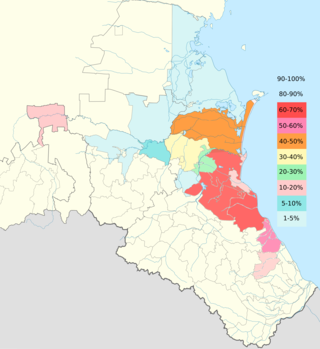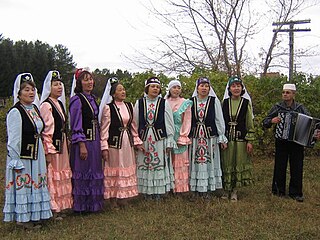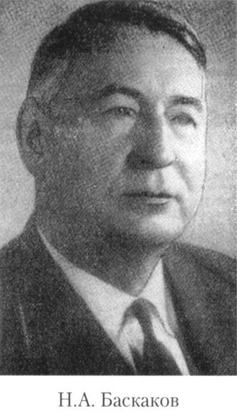
The Turkic languages are a language family of more than 35 documented languages, spoken by the Turkic peoples of Eurasia from Eastern Europe and Southern Europe to Central Asia, East Asia, North Asia (Siberia), and West Asia. The Turkic languages originated in a region of East Asia spanning from Mongolia to Northwest China, where Proto-Turkic is thought to have been spoken, from where they expanded to Central Asia and farther west during the first millennium. They are characterized as a dialect continuum.

Tatar is a Turkic language spoken by the Volga Tatars mainly located in modern Tatarstan, as well as Siberia and Crimea.
Abaza is a Northwest Caucasian language spoken by Abazins in Russia. The language has gone through several different orthographies based primarily on Latin and Cyrillic letters. Its consonant-to-vowel ratio is remarkably high; making it quite similar to many other languages from the same parent chain. The language evolved in popularity in the mid to late 1800s, but has become an endangered language.

The Altai Republic, also known as Gorno-Altai Republic, and colloquially, and primarily referred to in Russian to distinguish from the neighbouring Altai Krai as the Gornyi Altai, is a republic of Russia located in southern Siberia. The republic borders the Russian federal subjects of Kemerovo Oblast to the north, Khakassia to the northeast, Tuva to the east, Altai Krai to the west, as well it borders three countries: Mongolia to the southeast, China to the south and Kazakhstan to the southwest. It is a part of the Siberian Federal District, and covers an area of 92,903 square kilometers (35,870 sq mi), with a population of 210,924 residents. It is the least-populous republic of Russia and least-populous federal subject in the Siberian Federal District. Gorno-Altaysk is the capital and the largest town of the republic.
Altai is a set of Turkic languages spoken officially in the Altai Republic, Russia. The standard vocabulary is based on the Southern Altai language, though it's also taught to and used by speakers of the Northern Altai language as well. Gorno–Altai refers to a subgroup of languages in the Altai Mountains. The languages were called Oyrot (ойрот) prior to 1948.

Nogai also known as Noğay, Noghay, Nogay, or Nogai Tatar, is a Turkic language spoken in Southeastern European Russia, Kazakhstan, Uzbekistan, Ukraine, Bulgaria, Romania and Turkey. It is the ancestral language of the Nogais. As a member of the Kipchak branch, it is closely related to Kazakh, Karakalpak and Crimean Tatar. In 2014 the first Nogai novel was published, written in the Latin alphabet.

Kumyk is a Turkic language spoken by about 426,212 people, mainly by the Kumyks, in the Dagestan, North Ossetia and Chechen republics of the Russian Federation. Until the 20th century Kumyk was the lingua-franca of the Northern Caucasus.

Siberian Tatars or Sibirs/Sybyrs are the indigenous Turkic-speaking population of the forests and steppes of Western Siberia, originating in areas stretching from somewhat east of the Ural Mountains to the Yenisey River in Russia. The Siberian Tatars call themselves Yerle Qalıq, to distinguish themselves from more recent Volga Tatar immigrants to the region.
Chulym, also known as Chulim, Chulym-Turkic, is a critically endangered language of the Chulyms. The names which the people use to refer to themselves are 1. пистиҥ кишилер, pistɪŋ kiʃɪler and 2. ось кишилер, øs kiʃɪler. The native designation for the language are ось тил(и), øs til(ɪ) ~ ø:s til(ɪ), and less frequently тадар тил(и), tadar til(ɪ).

Teleuts are a Turkic Indigenous people of Siberia living in Kemerovo Oblast, Russia. According to the 2010 census, there were 2,643 Teleuts in Russia. They speak the Teleut language/dialect of Southern Altai language.

The Kumandins (natively, Kumandy, Kuvandy(g)) are a Turkic Indigenous people of Siberia. They reside mainly in the Altai Krai and Altai Republic of the Russian Federation. They speak the Northern Altai Kumandin language.

The Altai people, also the Altaians, are a Turkic ethnic group of indigenous peoples of Siberia mainly living in the Altai Republic, Russia. Several thousand of the Altaians also live in Mongolia and China but are not officially recognized as a distinct group and listed under the name "Oirats" as a part of the Mongols, as well as in Kazakhstan where they number around 200. For alternative ethnonyms see also Tele, Black Tatar, and Oirats. During the Northern Yuan dynasty, they were ruled in the administrative area known as Telengid Province.
The Kipchak languages are a sub-branch of the Turkic language family spoken by approximately 30 million people in much of Central Asia and Eastern Europe, spanning from Ukraine to China. Some of the most widely spoken languages in this group are Kazakh, Kyrgyz and Tatar.

Southern Altai is a Turkic language spoken in the Altai Republic, a federal subject of Russia located in Southern Siberia on the border with Mongolia and China. The language has some mutual intelligibility with the Northern Altai language, leading to the two being traditionally considered as a single language. According to modern classifications—at least since the middle of the 20th century—they are considered to be two separate languages.

Nikolai Aleksandrovich Baskakov was a Soviet Turkologist, linguist, and ethnologist. He created a systematization model of the Turkic language family, and studied Turkic-Russian contacts in the 10-11th centuries CE. During 64 years of scientific work (1930-1994), Baskakov published almost 640 works including 32 books. The main area of Baskakov's scientific interests was linguistics, but he also studied folklore and ethnography of the Turkic peoples, and also was a musician and composer.
The Hinukh are a people of Dagestan living in 2 villages: Genukh, Tsuntinsky District - their 'parent village' and Novomonastyrskoe, Kizlyarsky District - where they settled later and live together with Avars and Dargins and also in the cities of Dagestan. They are being assimilated by the Caucasian Avars.
Siberian Tatar (Сыбырца) is a Turkic language spoken in Western Siberia, Russia, primarily in the oblasts of Tyumen, Novosibirsk, Omsk but also in Tomsk and Kemerovo. According to Marcel Erdal, due to its particular characteristics, Siberian Tatar can be considered as a bridge to Siberian Turkic languages.

The Kumandin language is a Turkic language spoken in the Altai Republic in Russia.The Kumandins name themselves "Kumandi-Kiji".
Siberian dialects are a group of Northern Russian dialects under the serious lexical influence of the Southern Russian dialects and foreign inclusions. It is spoken by Siberian old-timers: Siberiaks, Chaldons, Kerzhaks, Cossacks, Old Believers, Pokhodchans (Kolymchans), Russian Ustians (Indigirshchiks), and Markovites (Anadyrshchiks).
Zagidat Magomedovna Magomedbekova was a Soviet, Russian and Georgian linguist known for her contribution to East Caucasian linguistics, specializing in the study of Andic languages. She is the author of the first comprehensive grammars of Akhvakh (1967) and Karata (1971), did research on Bagvalal, and wrote the articles on Akhvakh, Karata and Chamalal for the standard compendium Языки народов СССР.











